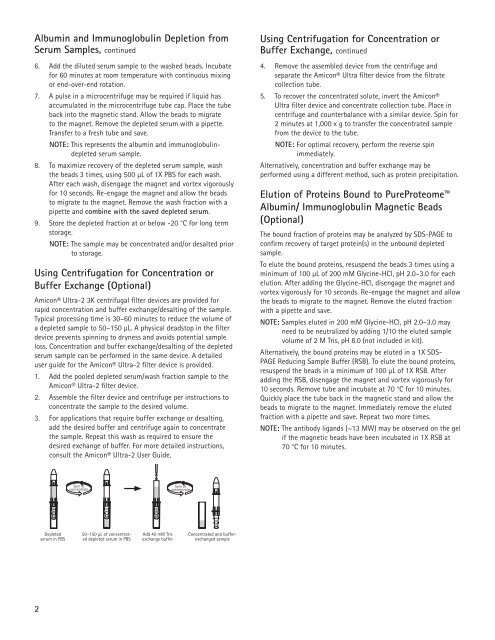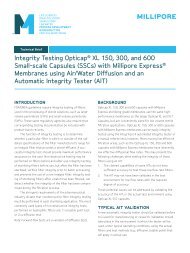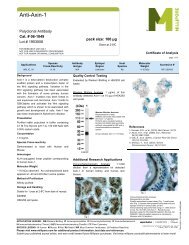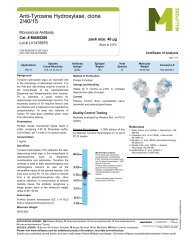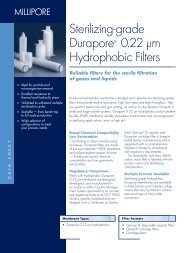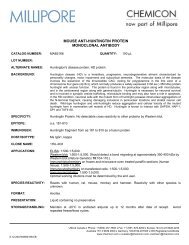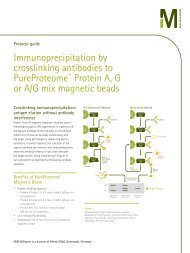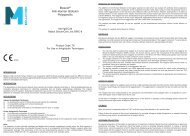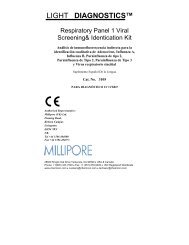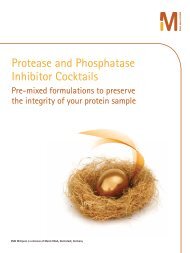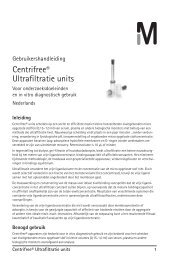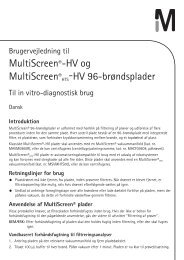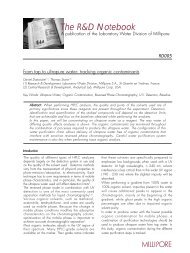PureProteome™ Human Albumin/ Immunoglobulin ... - Millipore
PureProteome™ Human Albumin/ Immunoglobulin ... - Millipore
PureProteome™ Human Albumin/ Immunoglobulin ... - Millipore
Create successful ePaper yourself
Turn your PDF publications into a flip-book with our unique Google optimized e-Paper software.
4 00<br />
3 00<br />
2 00<br />
1 00<br />
20<br />
4 00<br />
3 00<br />
2 00<br />
1 00<br />
20<br />
4 00<br />
3 00<br />
2 00<br />
1 00<br />
20<br />
4 00<br />
3 00<br />
2 00<br />
1 00<br />
20<br />
<strong>Albumin</strong> and <strong>Immunoglobulin</strong> Depletion from<br />
Serum Samples, continued<br />
6. Add the diluted serum sample to the washed beads. Incubate<br />
for 60 minutes at room temperature with continuous mixing<br />
or end-over-end rotation.<br />
7. A pulse in a microcentrifuge may be required if liquid has<br />
accumulated in the microcentrifuge tube cap. Place the tube<br />
back into the magnetic stand. Allow the beads to migrate<br />
to the magnet. Remove the depleted serum with a pipette.<br />
Transfer to a fresh tube and save.<br />
NOTE: This represents the albumin and immunoglobulindepleted<br />
serum sample.<br />
8. To maximize recovery of the depleted serum sample, wash<br />
the beads 3 times, using 500 μL of 1X PBS for each wash.<br />
After each wash, disengage the magnet and vortex vigorously<br />
for 10 seconds. Re-engage the magnet and allow the beads<br />
to migrate to the magnet. Remove the wash fraction with a<br />
pipette and combine with the saved depleted serum.<br />
9. Store the depleted fraction at or below -20 °C for long term<br />
storage.<br />
NOTE: The sample may be concentrated and/or desalted prior<br />
to storage.<br />
Using Centrifugation for Concentration or<br />
Buffer Exchange (Optional)<br />
Amicon® Ultra-2 3K centrifugal filter devices are provided for<br />
rapid concentration and buffer exchange/desalting of the sample.<br />
Typical processing time is 30–60 minutes to reduce the volume of<br />
a depleted sample to 50–150 µL. A physical deadstop in the filter<br />
device prevents spinning to dryness and avoids potential sample<br />
loss. Concentration and buffer exchange/desalting of the depleted<br />
serum sample can be performed in the same device. A detailed<br />
user guide for the Amicon® Ultra-2 filter device is provided.<br />
1. Add the pooled depleted serum/wash fraction sample to the<br />
Amicon® Ultra-2 filter device.<br />
2. Assemble the filter device and centrifuge per instructions to<br />
concentrate the sample to the desired volume.<br />
3. For applications that require buffer exchange or desalting,<br />
add the desired buffer and centrifuge again to concentrate<br />
the sample. Repeat this wash as required to ensure the<br />
desired exchange of buffer. For more detailed instructions,<br />
consult the Amicon® Ultra-2 User Guide.<br />
Using Centrifugation for Concentration or<br />
Buffer Exchange, continued<br />
4. Remove the assembled device from the centrifuge and<br />
separate the Amicon® Ultra filter device from the filtrate<br />
collection tube.<br />
5. To recover the concentrated solute, invert the Amicon®<br />
Ultra filter device and concentrate collection tube. Place in<br />
centrifuge and counterbalance with a similar device. Spin for<br />
2 minutes at 1,000 x g to transfer the concentrated sample<br />
from the device to the tube.<br />
NOTE: For optimal recovery, perform the reverse spin<br />
immediately.<br />
Alternatively, concentration and buffer exchange may be<br />
performed using a different method, such as protein precipitation.<br />
Elution of Proteins Bound to PureProteome<br />
<strong>Albumin</strong>/ <strong>Immunoglobulin</strong> Magnetic Beads<br />
(Optional)<br />
The bound fraction of proteins may be analyzed by SDS-PAGE to<br />
confirm recovery of target protein(s) in the unbound depleted<br />
sample.<br />
To elute the bound proteins, resuspend the beads 3 times using a<br />
minimum of 100 µL of 200 mM Glycine-HCl, pH 2.0–3.0 for each<br />
elution. After adding the Glycine-HCl, disengage the magnet and<br />
vortex vigorously for 10 seconds. Re-engage the magnet and allow<br />
the beads to migrate to the magnet. Remove the eluted fraction<br />
with a pipette and save.<br />
NOTE: Samples eluted in 200 mM Glycine-HCl, pH 2.0–3.0 may<br />
need to be neutralized by adding 1/10 the eluted sample<br />
volume of 2 M Tris, pH 8.0 (not included in kit).<br />
Alternatively, the bound proteins may be eluted in a 1X SDS-<br />
PAGE Reducing Sample Buffer (RSB). To elute the bound proteins,<br />
resuspend the beads in a minimum of 100 µL of 1X RSB. After<br />
adding the RSB, disengage the magnet and vortex vigorously for<br />
10 seconds. Remove tube and incubate at 70 °C for 10 minutes.<br />
Quickly place the tube back in the magnetic stand and allow the<br />
beads to migrate to the magnet. Immediately remove the eluted<br />
fraction with a pipette and save. Repeat two more times.<br />
NOTE: The antibody ligands (~13 MW) may be observed on the gel<br />
if the magnetic beads have been incubated in 1X RSB at<br />
70 °C for 10 minutes.<br />
Spin to<br />
concentrate<br />
Spin to<br />
concentrate<br />
10K<br />
10K<br />
10K<br />
10K<br />
Depleted<br />
serum in PBS<br />
50–150 µL of concentrated<br />
depleted serum in PBS<br />
Add 40 mM Tris<br />
exchange buffer<br />
Concentrated and bufferexchanged<br />
sample<br />
2


